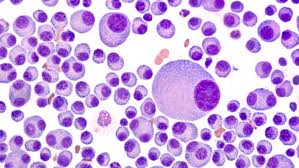
Diagnosed with Cancer? Your two greatest challenges are understanding cancer and understanding possible side effects from chemo and radiation. Knowledge is Power!
Learn about conventional, complementary, and integrative therapies.
Dealing with treatment side effects? Learn about evidence-based therapies to alleviate your symptoms.
Click the orange button to the right to learn more.
- You are here:
- Home »
- Blog »
- Multiple Myeloma »
- Newly Diagnosed- Multiple Myeloma Cancer Coaching Program?
Newly Diagnosed- Multiple Myeloma Cancer Coaching Program?

Although not often openly acknowledged, “cure vs control” is the dominant philosophical difference behind many of the strategies, trials, and debates related to the management of myeloma.
- Bone Marrow biopsy of 9/2- Early stage mm (19%) but monoclonal abnormalities
- Kappa FLC at 780- high but not too bad- increased to 847 by 9/23
- Lambda in normal range-
- LDH- 145 normal (120-246 range)
- Complete Metabolic Panel- all normal- creatinine, BUN, all normal- no kidney involvement
- B2M is high at 3.2- stage 1-
- Complete Blood Count- Red, White blood cells, hematocrit, hemo, all low- only slightly low but Mike, are you out of breath, fatigued?
- IgA is high at 2745- (range is 40-350)
- IgG is a bit low
- IgM is in range
- SPEP- m-spike of 1.4
3) Possible therapy plans-
Recommended Reading
- Multiple Myeloma Side Effects- Radiation-Induced Lumbosacral Plexopathy
- Antioxidants During Chemotherapy/Radiation?
- Multiple Myeloma Cancer Coaching Program
Treatment of Myeloma: Cure vs Control
“Although not often openly acknowledged, “cure vs control” is the dominant philosophical difference behind many of the strategies, trials, and debates related to the management of myeloma. Should we treat patients with myeloma with multidrug, multitransplant combinations with the goal of potentially curing a subset of patients, recognizing that the risk of adverse events and effect on quality of life will be substantial? Or should we address myeloma as a chronic incurable condition with the goal of disease control, using the least toxic regimens, emphasizing a balance between efficacy and quality of life, and reserving more aggressive therapy for later?
To be sure, if cure were known to be possible (with a reasonable probability) in myeloma, it would undoubtedly be the preferred therapeutic goal of most patients and physicians. But this is not the case. Myeloma is generally not considered a curable disease…”
Genetics of multiple myeloma: another heterogeneity level?
Conclusion
“Despite the use of the most promising genomic tools (GEP, SNP array, and NGS), MM remains a very heterogeneous disease, with no unique common mutation. The NGS studies in the past 5 years have characterized the suclonality concept. Even though NGS data can be considered disappointing because they do not show common mutations that could define subentities, they are nevertheless important because they confirm the wide molecular heterogeneity of the disease and the frequent occurrence of some supposedly “driver” mutations only in subclones.
This finding is important not only for our understanding of the biology of these genes in MM, but also for the hope of targeted therapies. It is clear that improvement in our understanding has been incremental and not exponential with successive utilization of various technologies and the molecular dissection of the disease, especially in the demonstration of suclonality. The objectives of future studies will be to analyze the 100 to 200 recurrent mutations (clonal or subclonal), in homogeneously treated cohorts of patients, in order to understand their significance in the evolution of MM, but also to learn how to deal with them in order to propose the best treatment to patients.”
Multiple Myeloma Cancer Coaching Program
“Hi, my name is David Emerson, and I’ve been a Multiple Myeloma survivor since 1994. I have been in remission since 1999.
No, you did not read that wrong. I am still here 25 years later, and I spend my days helping Multiple Myeloma patients decipher both the disease and the treatment options available with a heavy focus on treatment outcomes and patient experience.
I believe that informed patients make better healthcare decisions, and that pursuing evidence-based therapies shown to make a difference in your treatment outcomes is better than looking for a miracle myeloma cure.
But I made mistakes along my own Multiple Myeloma journey.
A lot of mistakes…”


